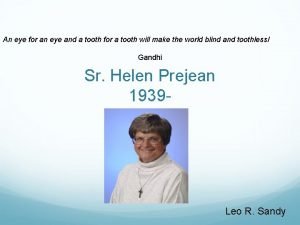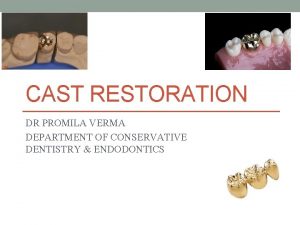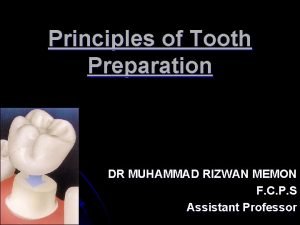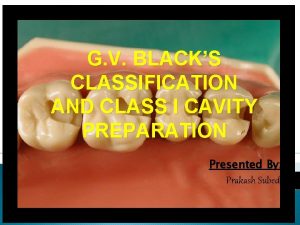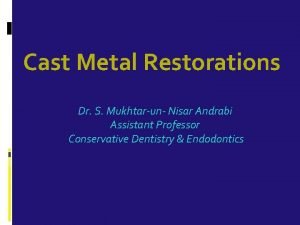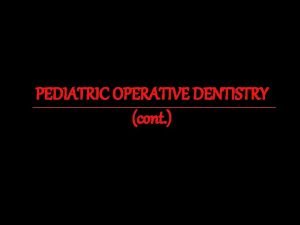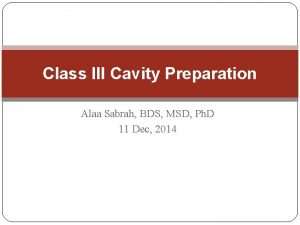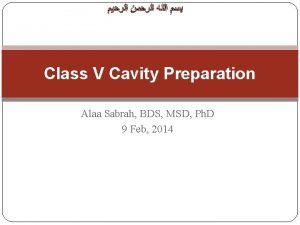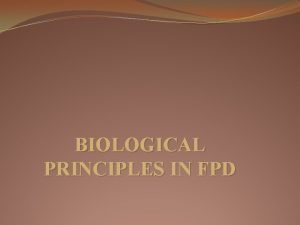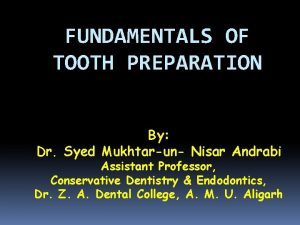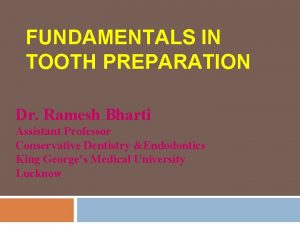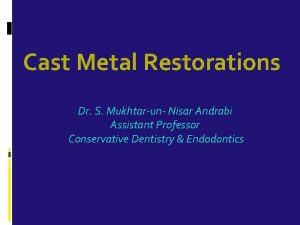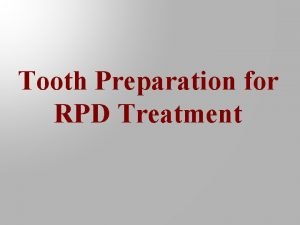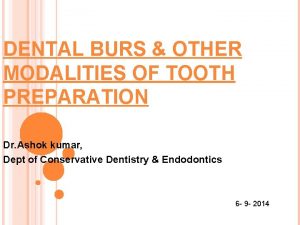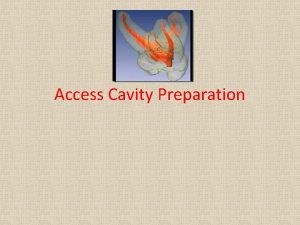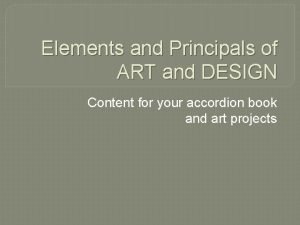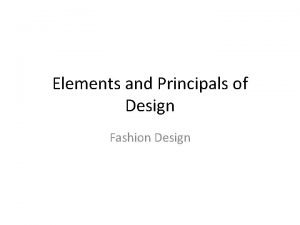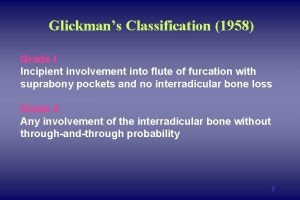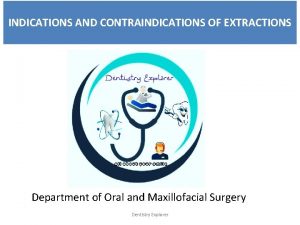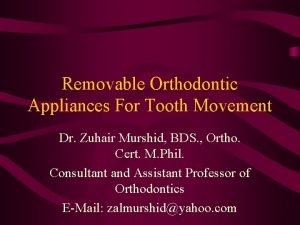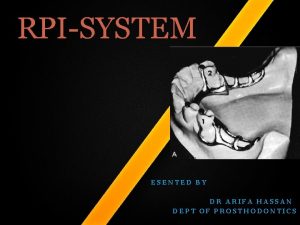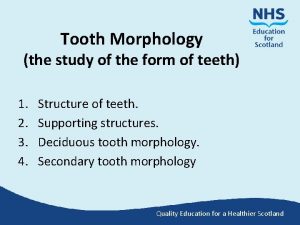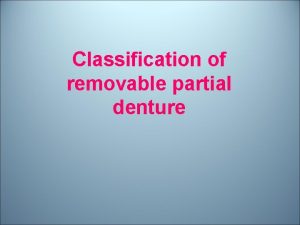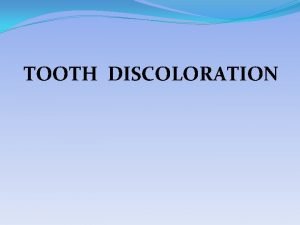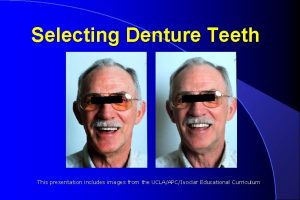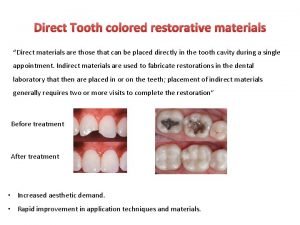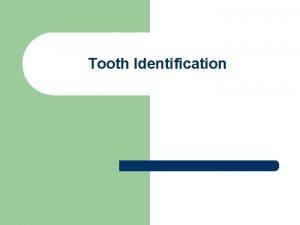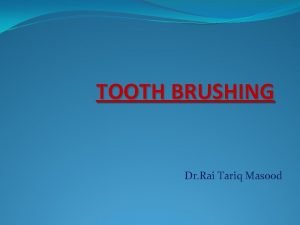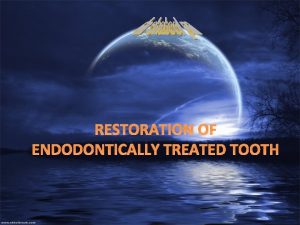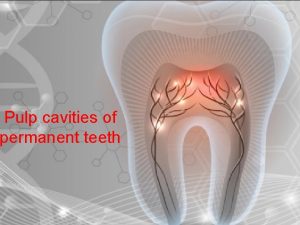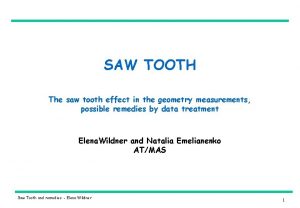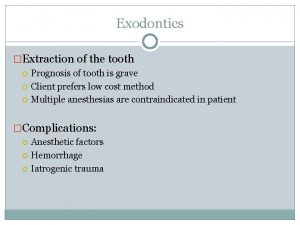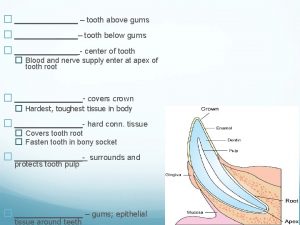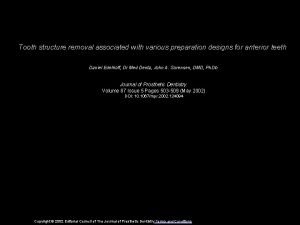PRINCIPALS OF TOOTH PREPARATION PRINCIPALS OF TOOTH PREPARATION








































- Slides: 40

PRINCIPALS OF TOOTH PREPARATION

PRINCIPALS OF TOOTH PREPARATION

BIOLOGIC CONSIDERATIONS Prevention of Damage During Tooth Preparation a) Adjacent teeth b) Soft tissues c) Pulp causes of injury temperature bacterial action chemical action

CONSERVATION OF TOOTH STRUCTURE ØPartial coverage rather than complete coverage ØPreparation with minimum convergence angle (taper) between axial walls ØPreparation of the occlusal surface so reduction follows the anatomic planes to give uniform thickness in the restoration ØPreparation of the axial surfaces so tooth structure is removed evenly; if necessary, teeth should be orthodontically repositioned ØSelection of a conservative margin compatible with the other principles of tooth preparation ØAvoidance of unnecessary apical extension of preparation

MARGIN PLACEMENT Whenever possible, the margin of the preparation should be supragingival. Advantages of supragingival margins include. 1. They can be easily finished with trauma to soft tissues. 2. They are more easily kept clean. 3. Impressions are more easily made, with less potential for soft tissue damage. 4. Restorations can be easily evaluated at recall appointments.

Indication of subgingival margin 1. Dental caries, cervical erosion, or restorations extend subgingivally and a crown lengthening procedure is not indicated. 2. The proximal contact area extends to the gingival crest. 3. Additional retention is needed. 4. The margin of a metal ceramic crown is to be hidden behind the labiogingival crest. 5. Root sensitivity cannot be controlled by more conservative procedures. 6. Modification of the axial contour is indicated.

MARGIN ADAPTATION The junction between a cemented restoration and the tooth is always a potential site for recurrent caries because of dissolution of the luting agent and inherent roughness. The more accurately the restoration is adapted to the tooth, the less will be the chance of recurrent caries or periodontal disease. A well designed preparation has a margin that is smooth and even. Rough, irregular, or "stepped" junctions greatly increase the length of the margin and substantially reduce the adaptation of the restoration

MARGIN GEOMETRY Guidelines for margin design 1. Ease of preparation without overextension. 2. Readily identifiable in the impression and on the die. 3. A distinct boundary to which the wax pattern can be finished. 4. Sufficient bulk of material (to enable the wax pattern to be handled without distortion as well as give the restoration strength and, when porcelain is used, esthetics). 5. Conservative of tooth structure (provided the other criteria are met).

PROPOSED MARGIN DESIGN FEATHER EDGE Advantage conservative Disadvantage does not provide sufficient bulk Indication not recommended

CHISEL EDGE Advantage conservative Disadvantage location of margin difficult to control Indication occasionaly on tilted teeth BEVEL EDGE Advantage remove unsupported enamel, allows finishing of metal Disadvantage extends preparation into sulcus if used on apical margin Indication facial margin of maxillary partial coverage crowns

CHAMFER Advantage distinct margin, adequate bulk, easier to control Disadvantage care needed to avoid unsupported lip of enamel Indication cast metal restorations, lingual margin of metal ceramic crowns SHOULDER Advantage bulk of restorative material, Disadvantage less conservative Indication facial margin of metal ceramic crowns, complete ceramic crowns

SLOPED SHOULDER Advantage bulk of material, advantages of bevel Disadvantage less conservative Indication facial margin of metal ceramic crowns SHOULDER WITH BEVEL Advantage bulk of material, advantages of bevel Disadvantage less conservative, extends preparation apically Indication facial margin of posterior metal ceramic crowns with supragingival margins

MECHANICAL CONSIDERATIONS ØRetention form ØResistance form

RETENTION FORM The quality of a preparation that prevents the restoration from becoming dislodged by such forces parallel to the path of withdrawal is known as retention Factors determining retention I. Magnitude of the dislodging forces The magnitude of the dislodging forces depends on the stickiness of the food and the surface area and tex tureof the restoration being pulled.

2. Geometry of the tooth preparation a)Taper As the taper increases, however, so does the free movement of the restoration and retention will be reduced. Selection of the appropriate degree of taper for tooth preparation involves compromise. Too small a taper may lead to unwanted undercuts; too large will no longer be retentive. The recommended convergence between opposing walls is 6 degrees.

b)surface area Retention is dependent on the length of path of withdrawal or, more precisely, on the surface area in sliding contact. Therefore, crowns with long axial walls are more retentive than those with short axial walls c)stress concentration changes in the geometry of the preparation (e. g. , rounding the internal line angles) may reduce stress concentrations and hence increase the retention of the restoration.

d)Type of preparation Different types of preparation have different retentive values and these correspond fairly closely to the surface area of the axial walls, provided other factors (e. g. , taper) are kept constant. Thus the retention of a complete crown is about double that of partial coverage restorations.

3. Roughness of the fitting surface of the restoration. The more the roughness of the internal surface of a restoration, the more the retention 4. Type of luting agent The type of luting agent chosen affects the retention of a cemented restoration. Adhesive resin cements are the more retentive than other cement.

RESISTANCE FORM Resistance prevents dislodgement of the restoration by forces directed in an apical or oblique direction and prevents any movement of restoration under occlusal forces. Factors determining resistance Leverage Forces should pass with the margin of a crown

Length of the preparation Longer preparation will have more surface area and will be more retentive. Because the axial wall occlusal to the finish line interferes with displacement, the length and inclination of that wall become factors in resistance to tipping forces. for a restoration to succeed, the length must be great enough to interfere with the arch of the casting pivoting about a point on the margin on the opposite side of the restoration. Resistance can be increased by grooves.

Path of insertion which the restoration will be placed onto or removed from the preparation. The path of all abutments should be parallel to each other The path of insertion must be considered in two dimension: faciolingually and mesiodistally. ØThe faciolingual orientation of the path can affect the esthetics of metal ceramic or partial veneer crowns. ØThe mesiodistal inclination of the path must parallel the contact areas of the adjacent teeth.

STRUCTURAL DURABILITY A restoration should have sufficient bulk of material that is adequate to withstand the forces of occlusion. This bulk must be confined to the space created by the tooth preparation. Only by this way can the occlusion on the restoration can be harmonious and the axial contour normal, preventing periodontal problems around the restoration.

OCCLUSAL REDUCTION Sufficient occlusal clearance should be provided to provide adequate bulk of metal and strength to the restoration. Recommended reduction MATERIAL Functional cusp PFM Metal 2 mm 1. 5 2 mm Non functional cusp 1. 5 mm 1 mm Gold 1. 5 mm 1 mm

FUNCTIONAL CUSPAL BEVEL The Functional cuspal bevel is given on buccal cusp of lower and palatal cusp of upper teeth. This provides for adequate bulk of material in an area of heavy occlusal contact.

If the bevel is not placed several problems may arise ØThe casting will be extremely thin in the area overlying the junction between the occlusal and axial reduction.

ØAn overcontoured restoration may result ØIf an attempt is made to obtain space for an adequate bulk in a normally contoured casting without a bevel, the result will be an overcut axial surface.

AXIAL REDUCTION It is essential that a tooth preparation provide sufficient space for the development of good axial contours. This will enable the junction between the restoration and the tooth to be smooth and free of any ledges or abrupt changes in direction. Sufficient tooth structure must be removed to allow the development of correctly formed axial contours, particularly in the interproximal and furcation areas, where periodontal disease often begins.

Sufficient axial reduction allows bulk of the restorative material which prevents distortion of the material under occlusal load. The features that will serve to provide space for metal that will improve the rigidity and durability of the restoration are the offset, the occlusal shoulder, the isthmus, the proximal groove and the box.

ESTHETIC CONSIDERATION Whenever possible, accomplishment of an esthetically acceptable result without the use of metal ceramic crowns is preferred, not only because tooth structure is conserved but also because no restorative material can approach the appearance of intact tooth enamel.

THE COMPLETE CAST CROWN INDICATION ØExtensive destruction from caries or trauma ØEndodontically treated teeth ØExisting restoration ØNecessity for maximum retention and strength ØTo provide contour to receive a removable appliance CONTRAINDICATION ØLess than maximum retention necessary ØEsthetics

ADVANTAGE ØStrong ØHigh retentive qualities ØUsually easy to obtain adequate resistance form ØOption to modify form and occlusion DISADVANTAGE ØAdverse effects on metal ØVitality testing not readily feasible ØDisplay of metal

CRITERIA

METAL CERAMIC CROWN INDICATION ØEsthetics ØIf porcelain jacket crown is contraindicated ØGingival involvement CONTRAINDICATION ØLarge pulp chamber ØIntact buccal wall ØWhen more conservative retainer is technically feasible

ADVANTAGE ØSuperior esthetics as compared to cast gold restoration DISADVANTAGE ØRemoval of substantial tooth structure ØSubject to fracture because porcelain is brittle ØDifficult to obtain accurate occlusion in glazed porcelain ØShade selection can be difficult ØInferior esthetics as compared to porcelain jacket crown ØExpensive

CRITERIA

ALL CERAMIC CROWN INDICATION ØHigh esthetic requirement ØConsiderable proximal caries ØIncisal edge reasonably intact ØEndodontically treated teeth with post and core ØFavorable distribution of occlusal load CONTRAINDICATION ØWhen superior strength is required ØThin teeth faciolingually ØUnfavorable distribution of occlusal load

ADVANTAGE ØEsthetically unsurpassed ØGood tissue response DISADVANTAGE ØReduced strength compared to metal ceramic crown ØProper preparation extremely critical ØBrittle nature of material

CRITERIA


 An eye for an eye a tooth for a tooth sister act
An eye for an eye a tooth for a tooth sister act Primary flare in inlay
Primary flare in inlay Shoulder vs chamfer
Shoulder vs chamfer Black 1 cavity
Black 1 cavity Bevel in class 5 cavity preparation
Bevel in class 5 cavity preparation Skirt in tooth preparation
Skirt in tooth preparation Isthmus tooth prep
Isthmus tooth prep Axial wall
Axial wall Class 5 tooth preparation
Class 5 tooth preparation Resistance form in fpd
Resistance form in fpd Secondary retention and resistance form
Secondary retention and resistance form Primary retention form features
Primary retention form features Cast metal restoration
Cast metal restoration Skirt preparation in conservative dentistry
Skirt preparation in conservative dentistry Guiding planes on abutment teeth
Guiding planes on abutment teeth Factors affecting cutting efficiency of dental burs
Factors affecting cutting efficiency of dental burs Law of centrality endodontics
Law of centrality endodontics Naplan online test administration handbook for teachers
Naplan online test administration handbook for teachers It brings together a composition with similar units.
It brings together a composition with similar units. Leadership traits
Leadership traits Na guiding principles
Na guiding principles Auckland primary principals association
Auckland primary principals association Principals of design
Principals of design Kiwi leadership for principals
Kiwi leadership for principals Basic principle of cooking
Basic principle of cooking South african principals association
South african principals association International confederation of principals
International confederation of principals Time management for principals
Time management for principals Mx1st
Mx1st Ney surveyor
Ney surveyor Indications and contraindications of extraction
Indications and contraindications of extraction Factors affecting balanced occlusion
Factors affecting balanced occlusion Components of removable orthodontic appliances
Components of removable orthodontic appliances Rpi denture
Rpi denture Mesial surface of tooth
Mesial surface of tooth Class 3 mod 1 rpd design
Class 3 mod 1 rpd design Classification of tooth discoloration
Classification of tooth discoloration What is this
What is this Portrait denture teeth
Portrait denture teeth Fränkel 2 appliance uses
Fränkel 2 appliance uses Tooth colored restorative materials
Tooth colored restorative materials
